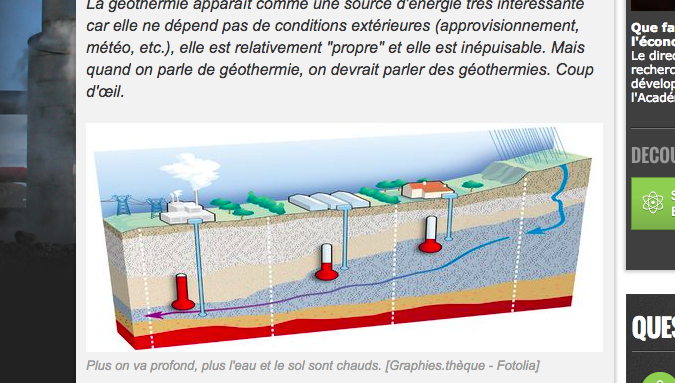The different types of geothermal resources – in the context of Switzerland
In this interesting piece, an overview on the geothermal resources in Switzerland is given.
Geothermal energy is a very interesting source of energy because it does not depend on external conditions (supply, weather, etc.), it is relatively “clean” and it is inexhaustible. In a descriptive piece on Swiss media outlet RTS, an interesting description of geothermal energy resources in the context of Switzerland is given. Essentially, geothermal resources available in Switzerland can be described as follows.
1. Shallow geothermal energy (30 to 400 meters)
From a few meters below the surface of the ground, the temperature of the Earth is constant all year round. This form of individual geothermal energy, which is the most widespread in Switzerland, draws energy from the subsoil using one (or more) vertical probe, usually at a depth of between 120 and 150 meters. At this depth, the soil temperature is between 12° and 15° Celsius.
Liquid is injected into a U-shaped tube. It heats up in contact with the heat of the subsoil and then rises to the surface. The recovered heat is not sufficient and must be upgraded by a heat pump to supply radiators or underfloor heating. In summer, this low temperature can be used to cool a home.

2. Deep geothermal energy (from 400 meters depth)
On the Swiss Plateau, the water temperature between 1 and 4 kilometers deep reaches between 40° and 130° Celsius. The exploitation in hydrothermal form is one of the techniques of recovery of this energy.
A pump recovers the water present in the soil using a borehole called “production”. Through a heat exchanger, the thermal energy of this water and taken and injected into another liquid to a remote heating network. If the temperature is not high enough, it can be increased by means of a heat pump. If the temperature of the geothermal fluid is sufficient, electricity can be produced. The water from the production hole is reinjected into the basement or discharged into a stream or lake.
2. Geothermal energy of great depth (from 4,000 to 6,000 meters)
Between 4,000 and 6,000 meters, the temperature of the rock reaches 200° Celsius. The recovery of this energy makes it possible to produce electricity and heating.
Drilling is done to reach this rock. Then, stimulation is carried out with water under high pressure to improve the permeability of this rock. Water is injected into this fizzures via a second borehole, it is heated by contact with the rock, and then pumped to the surface. With the aid of a heat exchanger, the thermal energy heats up and transforms into a pressurized gas a working liquid. The latter produces electricity by operating a turbogenerator. The residual heat is injected into a remote heating network. The pumped water is returned to the soil after cooling.
This SGS technology (stimulated geothermal systems, or called in the industry Engineered Geothermal Systems (EGS)) is promising for Switzerland, but due to deep stimulation of the rock, it is likely to cause earthquakes. This led to the end of a major project in Basel in 2007.
Source: RTS – Discovery, Switzerland, AFPG


















